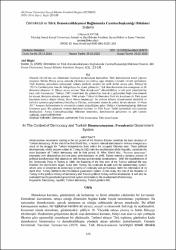| dc.contributor.author | Kantar, Gökmen | |
| dc.date.accessioned | 2022-05-11T14:33:44Z | |
| dc.date.available | 2022-05-11T14:33:44Z | |
| dc.date.issued | 2020 | |
| dc.identifier.issn | 2149-0767 | |
| dc.identifier.uri | https://doi.org/10.31592/aeusbed.664875 | |
| dc.identifier.uri | https://app.trdizin.gov.tr/makale/TXpZMk9URTJOZz09 | |
| dc.identifier.uri | https://hdl.handle.net/20.500.11776/7888 | |
| dc.description.abstract | Osmanlı Devleti’nin son döneminde başlayan modernleşme hareketleri, Türk demokrasinin temel yapısını oluşturur. Birinci Dünya savaşı sonunda yıkılmaya yüz tutmuş, işgal altındaki Osmanlı Devleti içerisinden; Türk Kurtuluş mücadelesi neticesinde Ankara merkezli modern bir millî devlet ortaya çıktı. Türkiye’de 1923’te Cumhuriyetin ilanı ile belirginleşen bu siyasi gelişmeler, Türk demokrasisinin ana omurgasını ve ilk dönemini oluşturur. II. Dünya savaşı sonrası “Batı demokrasisi” diktatörlüklere ve tek parti yönetimlerine karşı zafer kazanmıştır. Türkiye, 1945 yılında hem dış gelişmelere hem de iç gelişmelere bağlı olan dinamik bir siyasal dönüşüm sürecine girmiştir. 1946 yılında Türkiye’de Demokrat Parti’nin kurulması ile Türk siyasi hayatında kurucu dönem bitmiş; ikinci dönem başlamıştır. Bu tarihten itibaren demokrasisini süreklilik ve kalıcılık açısından güçlendirmeyi hedefleyen Türkiye, parlamenter sistem ile yoluna devam etmiştir. 16 Nisan 2017 Anayasa Referandumu ile yönetimde yöntem değişikliğine giden Türkiye, Cumhurbaşkanlığı Hükümet Sistemine geçti. Bu çalışmada modern demokrasi kavramı ve Türk Siyasi Tarihi içerisindeki rolü üzerinde durulacaktır. Ayrıca Cumhurbaşkanlığı Hükümet sisteminin, demokrasinin gelişimine ne gibi katkılar sağladığı, değerlendirilecektir. | en_US |
| dc.description.abstract | Modernization movements starting in the last period of the Ottoman Empire constitute the basic structure of Turkish democracy. At the end of the first World War, a modern national state based in Ankara emerged as a result of the struggle for Turkish independence from within the occupied Ottoman state. These political developments, which became evident in Turkey in 1923 with the proclamation of the Republic, constitute the main backbone of Turkish democracy and its first period. II. After World War, “Western democracy” triumphed over dictatorships and one-party administrations. In 1945, Turkey entered a dynamic process of political transformation that depends on both foreign and domestic developments. With the establishment of the Democratic Party in Turkey in 1946, the founding of the first term of the Turkish political life was finished; the second term began. Since then, Turkey has continued its path with the parliamentary system, which aims to strengthen its democracy in terms of continuity and permanence. With the referendum of 16 April 2017, Turkey shifted to the Presidential government system. In this study, the role of the Republic of Turkey in the political history of democracy and Turkish political history will be emphasized. It will also be evaluated how the presidential government system contributes to the development of democracy. | en_US |
| dc.language.iso | tur | en_US |
| dc.identifier.doi | 10.31592/aeusbed.664875 | |
| dc.rights | info:eu-repo/semantics/openAccess | en_US |
| dc.title | Demokrasi ve Türk Demokratikleşmesi Bağlamında Cumhurbaşkanlığı Hükümet Sistemi | en_US |
| dc.title.alternative | In the Context of Democracy and Turkish Democratızatıon; Presıdential Government System | en_US |
| dc.type | article | en_US |
| dc.relation.ispartof | Ahi Evran Üniversitesi Sosyal Bilimler Enstitüsü Dergisi | en_US |
| dc.department | Fakülteler, İktisadi ve İdari Bilimler Fakültesi, Siyaset Bilimi ve Kamu Yönetimi Bölümü | en_US |
| dc.identifier.volume | 6 | en_US |
| dc.identifier.issue | 1 | en_US |
| dc.identifier.startpage | 123 | en_US |
| dc.identifier.endpage | 135 | en_US |
| dc.institutionauthor | Kantar, Gökmen | |
| dc.identifier.trdizinid | TXpZMk9URTJOZz09 | en_US |



















